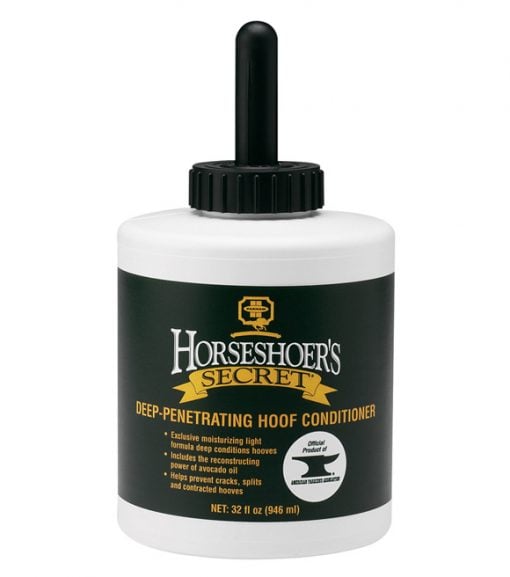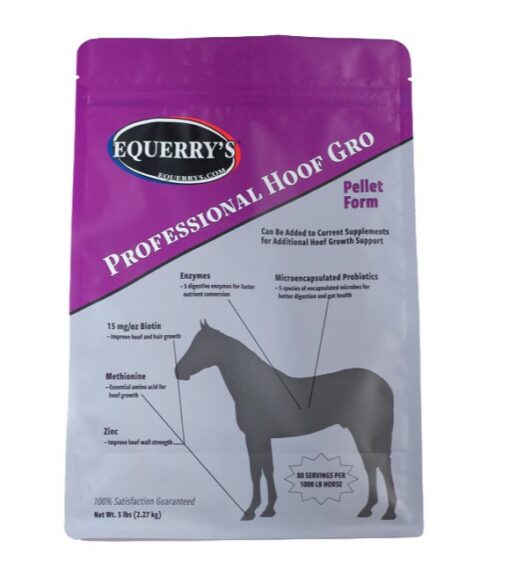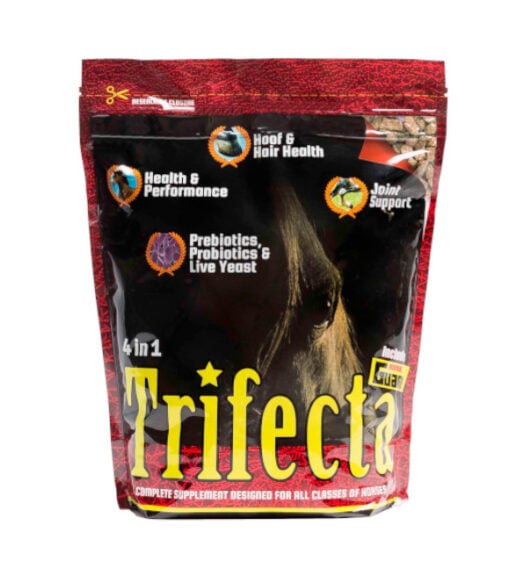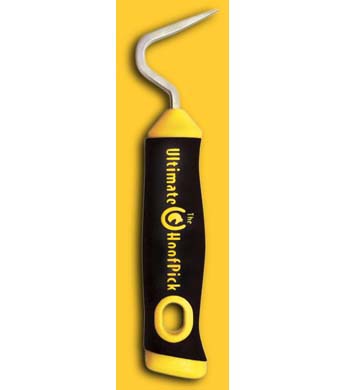Have you ever heard the phrase, “no hoof, no horse”?
It means that without the stability of their feet, your horse won’t be able to function on a day-to-day basis.
Keep reading to find out about two of the most common hoof problems and how to handle them.

Thrush
What is thrush?
Thrush is a type of infection in the frog area of the hoof. It is most commonly seen in horses whose feet are exposed to moisture for long periods of time. It happens a lot during the winter and spring when the ground has not had a chance to dry out.

How can I tell if my horse has thrush?
There are a few different ways that you can tell if your horse has thrush.
The first, and most noticeable, one is that the frog has turned black.
The second thing you’ll notice is that when you clean the hoof, the area that you have cleaned will have a very similar smell to sulfur or rotten eggs. It may not be a very strong smell, but it is definitely one that is recognizable.
The infection usually happens in the frog area and in the grooves on either side of the frog. However, it can spread to other areas of the hoof.
In the more serious cases, there will be an oily substance that will ooze out of the frog area. You may notice that your horse is limping or is sensitive in their hoof or leg area. Call your veterinarian immediately if this occurs.
How do I treat thrush?
There are many ways to treat thrush depending on its severity. Make sure you always check in with your farrier or veterinarian before starting any treatment plan.
Here are some basic treatment tips you can do until an expert arrives:
- Take your horse into an area that is completely dry and has stable footing.
- Take your hoof pick and clean your horse’s hooves as best as you can, or as they will allow.
- If your vet or farrier can’t make it out for a day or so, try spraying the hoof with an antiseptic such as iodine, Thrush Buster, or vinegar. Make sure to ask your chosen professional what product they recommend first before you use it.
When your farrier or vet comes out they may recommend using a poultice or hoof packing to draw out the infection before completing your horse’s treatment. Don’t be surprised if they recommend more frequent farrier visits. This is just to make sure that the infection isn’t hanging around and that your horse’s hooves stay balanced or cleaned out.
If your horse has a severe case of thrush, you may have to board your horse in a stall until they are completely healed.
DO NOT USE BLEACH ON YOUR HORSE’S HOOVES.
While this may be a great way to get rid of bacteria in your home or laundry, this product is not meant for use on any organic material such as skin, hair, or hooves. It will cause more damage and may end up chemically burning your horse’s feet.

Quarter Cracks
Why are my horse’s hooves cracked?
Quarter cracks can happen for a few different reasons, such as ground condition changes (from wet to extremely dry), a lack of exercise, or poor nutrition.
The good news is that there are easy solutions to all of these problems.
If your horse is living in a place that is constantly going from wet ground conditions to extremely dry, or if you live in a place that is constantly dry (like the desert, or the southern States), your best friend is going to be a good quality hoof conditioner.
The most recommended hoof conditioner for dry and cracked hooves is Horseshoer’s Secret. It is easy to apply and comes in a large container.
Make sure you check with your vet or farrier on the proper application of this product. You don’t want your horse’s hooves to have too much moisture in them because then they can develop bacteria.
If your horse is still having issues with quarter cracks, you can try adding in a hoof-strengthening supplement such as Equerry’s or Horse Guard Trifecta.
When using the hoof conditioner and supplement, make sure that your horse is getting regular exercise, especially if they are being boarded in a stall.

Trail boots vs horseshoes
Which is better?
There is no right answer to this question. It all depends on your horse’s needs and what will be the best for them in the long run for top-quality hoof care.
Horseshoes are great for horses that have overly tender feet and are kept in a space that has harder, more rock ground conditions whereas boots are really good if you just need a temporary fix, especially while trail riding.
Whereas, boots are really good if you just need a temporary fix especially while trail riding. Boots are great for if your horse has quarter cracks, or is in recovery from any sort of thrush that may cause them to be tender, but they still need to be ridden. Boots will make sure that your horse does not get any bruises, rocks or debris in their hooves while you’re out riding.

Why should I put shoes on my horse?
If your horse is being worked a lot, you may consider putting shoes on them.
A lot of different breeds of horses have feet that are super solid and can deal with the wear and tear of daily riding. However, quite a few breeds of horses don’t have sound feet. There are a lot of factors to look at when considering putting shoes on.
- Does my horse only need a hoof supplement?
- Do they get worked a lot?
- What does their environment look like?
These are just a few questions that you should be asking yourself (and your farrier) before putting shoes on your horse.
If your horse is having confirmation problems, shoes can also help correct that.
While we all love to hear the “clip-clop” sound of a freshly shod horse walking up the path, the biggest thing to remember is to talk to your farrier before requesting to put shoes on your horse.
There might be a better alternative to what kind of care that your horse’s hooves will need.
What tools should I keep on hand if I have shoes on my horse?
If you and your farrier decide to put shoes on your horse, there are a few tools that you should keep with you at all times:
- A hoof rasp
- A rasp is used for filing down your horse’s hoof (much like a nail file for human nails). Keep one of these in your tack room and trailer. If a shoe ends up falling off, you can rasp down the edge of your horse’s hoof to help prevent cracks.
- Nippers
- Nippers are a very valuable tool when you have a horse that has shoes on. If your horse has a loose shoe that is being held on with a single nail and a prayer, this tool can help you to clip that nail and save both the shoe and your horse’s hoof.
- Nippers are a very valuable tool when you have a horse that has shoes on. If your horse has a loose shoe that is being held on with a single nail and a prayer, this tool can help you to clip that nail and save both the shoe and your horse’s hoof.
- Hoof pick
- It goes without saying that you probably have a couple dozen of these floating around your barn. Make sure there is always one within reach, in case your horse gets a rock or some other debris stuck in their shoe.
- It goes without saying that you probably have a couple dozen of these floating around your barn. Make sure there is always one within reach, in case your horse gets a rock or some other debris stuck in their shoe.
Make sure you ask your farrier to instruct you on the proper way to use each tool.
When should I use trail boots?
An alternative to shoes is using trail boots on your horse.
If you are out riding trails a lot, your horse can develop stone bruises or other issues with their hooves.
Even if they’re prone to quarter cracks and chipping, a well-fitted pair of trail boots can help keep the damage to a minimum.
If you’re in the market for a pair of trail boots for your horse, check out Cavallo. Their boots are lightweight and have a secure fastening system with industrial-grade velcro and a billet fastener.
Need something for your horse’s hooves, but couldn’t find it here? Trot on down to your local Wilco Farm Store and ask our Animal Health Specialists for their recommendations.






